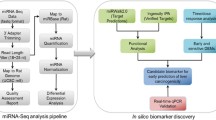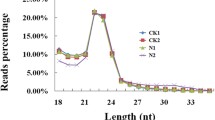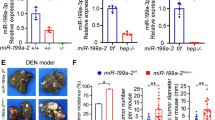Abstract
Ginkgo biloba extract (GBE) is used in traditional Chinese medicine as a herbal supplement for improving memory. Exposure of B6C3F1/N mice to GBE in a 2-year National Toxicology Program (NTP) bioassay resulted in a dose-dependent increase in hepatocellular carcinomas (HCC). To identify key microRNAs that modulate GBE-induced hepatocarcinogenesis, we compared the global miRNA expression profiles in GBE-exposed HCC (GBE-HCC) and spontaneous HCC (SPNT-HCC) with age-matched vehicle control normal livers (CNTL) from B6C3F1/N mice. The number of differentially altered miRNAs in GBE-HCC and SPNT-HCC was 74 (52 up and 22 down) and 33 (15 up and 18 down), respectively. Among the uniquely differentially altered miRNAs in GBE-HCC, miR-31 and one of its predicted targets, Cdk1 were selected for functional validation. A potential miRNA response element (MRE) in the 3′-untranslated regions (3′-UTR) of Cdk1 mRNA was revealed by in silico analysis and confirmed by luciferase assays. In mouse hepatoma cell line HEPA-1 cells, we demonstrated an inverse correlation between miR-31 and CDK1 protein levels, but no change in Cdk1 mRNA levels, suggesting a post-transcriptional effect. Additionally, a set of miRNAs (miRs-411, 300, 127, 134, 409-3p, and 433-3p) that were altered in the GBE-HCCs were also altered in non-tumor liver samples from the 90-day GBE-exposed group compared to the vehicle control group, suggesting that some of these miRNAs could serve as potential biomarkers for GBE exposure or hepatocellular carcinogenesis. These data increase our understanding of miRNA-mediated epigenetic regulation of GBE-mediated hepatocellular carcinogenesis in B6C3F1/N mice.







Similar content being viewed by others
Abbreviations
- AsOs:
-
Antisense oligonucleotides
- CNTL:
-
Control
- DEGs:
-
Differentially expressed genes
- DmiRs:
-
Differentially expressed miRNAs
- FC:
-
Fold change
- FDR:
-
False discovery rate
- FFPE:
-
Formalin-fixed paraffin embedded
- GBE:
-
Ginkgo biloba extract
- H&E:
-
Hematoxylin and eosin
- HCC:
-
Hepatocellular carcinoma
- miRNA:
-
MicroRNA
- mmu-miR:
-
Mus musculus MicroRNA
- MRE:
-
MiRNA response element
- NTP:
-
National Toxicology Program
- RMA:
-
Robust multiarray normalization
- SPNT:
-
Spontaneous
References
Benjamini Y, Hochberg Y (1995) Controlling the false discovery rate: a practical and powerful approach to multiple testing. J R Stat Soc: Ser B (Methodol) 57(1):289–300
Bolstad BM, Irizarry RA, Astrand M, Speed TP (2003) A comparison of normalization methods for high density oligonucleotide array data based on variance and bias. Bioinformatics 19(2):185–193. https://doi.org/10.1093/bioinformatics/19.2.185
Bouhaddioui W, Provost PR, Tremblay Y (2014) Identification of most stable endogenous control genes for microRNA quantification in the developing mouse lung. PLoS ONE 9(11):e111855. https://doi.org/10.1371/journal.pone.0111855
Brinkley TE, Lovato JF, Arnold AM et al (2010) Effect of Ginkgo biloba on blood pressure and incidence of hypertension in elderly men and women. Am J Hypertens 23(5):528–533. https://doi.org/10.1038/ajh.2010.14
Catlin NR, Collins BJ, Auerbach SS et al (2018) How similar is similar enough? A sufficient similarity case study with Ginkgo biloba extract. Food Chem Toxicol 118:328–339. https://doi.org/10.1016/j.fct.2018.05.013
Cottonham CL, Kaneko S, Xu L (2010) miR-21 and miR-31 converge on TIAM1 to regulate migration and invasion of colon carcinoma cells. J Biol Chem 285(46):35293–35302. https://doi.org/10.1074/jbc.M110.160069
Davidson G, Niehrs C (2010) Emerging links between CDK cell cycle regulators and Wnt signaling. Trends Cell Biol 20(8):453–460. https://doi.org/10.1016/j.tcb.2010.05.002
DeKosky ST, Williamson JD, Fitzpatrick AL et al (2008) Ginkgo biloba for prevention of dementia a randomized controlled trial. JAMA J Am Med Assoc 300(19):2253–2262. https://doi.org/10.1001/jama.2008.683
Diamond BJ, Bailey MR (2013) Ginkgo biloba: indications, mechanisms, and safety. Psychiatr Clin N Am 36(1):73–83. https://doi.org/10.1016/j.psc.2012.12.006
Ding W, Tan H, Zhao C et al (2016) MiR-145 suppresses cell proliferation and motility by inhibiting ROCK1 in hepatocellular carcinoma. Tumour Biol 37(5):6255–6260. https://doi.org/10.1007/s13277-015-4462-3
Du Z, Niu S, Xu X, Xu Q (2017) MicroRNA31-NDRG3 regulation axes are essential for hepatocellular carcinoma survival and drug resistance. Cancer Biomark 19(2):221–230. https://doi.org/10.3233/CBM-170568
Dutta R, Mahato RI (2017) Recent advances in hepatocellular carcinoma therapy. Pharmacol Ther 173:106–117. https://doi.org/10.1016/j.pharmthera.2017.02.010
EMA/HMPC/321095/2012 (2014) Assessment report on Ginkgo biloba L., folium. European Medicines Agency
Enserink JM, Kolodner RD (2010) An overview of Cdk1-controlled targets and processes. Cell Div 5:11. https://doi.org/10.1186/1747-1028-5-11
Firestein R, Bass AJ, Kim SY et al (2008) CDK8 is a colorectal cancer oncogene that regulates beta-catenin activity. Nature 455(7212):547–551. https://doi.org/10.1038/nature07179
Fornari F, Gramantieri L, Ferracin M et al (2008) MiR-221 controls CDKN1C/p57 and CDKN1B/p27 expression in human hepatocellular carcinoma. Oncogene 27(43):5651–5661. https://doi.org/10.1038/onc.2008.178
Fu LL, Wen X, Bao JK, Liu B (2012) MicroRNA-modulated autophagic signaling networks in cancer. Int J Biochem Cell Biol 44(5):733–736. https://doi.org/10.1016/j.biocel.2012.02.004
Gramantieri L, Ferracin M, Fornari F et al (2007) Cyclin G1 is a target of miR-122a, a microRNA frequently down-regulated in human hepatocellular carcinoma. Cancer Res 67(13):6092–6099. https://doi.org/10.1158/0008-5472.CAN-06-4607
Griffiths-Jones S (2004) The microRNA registry. Nucleic Acids Res 32:109–111. https://doi.org/10.1093/nar/gkh023
Herrschaft H, Nacu A, Likhachev S, Sholomov I, Hoerr R, Schlaefke S (2012) Ginkgo biloba extract EGb 761(R) in dementia with neuropsychiatric features: a randomised, placebo-controlled trial to confirm the efficacy and safety of a daily dose of 240 mg. J Psychiatr Res 46(6):716–723. https://doi.org/10.1016/j.jpsychires.2012.03.003
Hoenerhoff MJ, Pandiri AR, Snyder SA et al (2013) Hepatocellular carcinomas in B6C3F1 mice treated with Ginkgo biloba extract for two years differ from spontaneous liver tumors in cancer gene mutations and genomic pathways. Toxicol Pathol 41(6):826–841. https://doi.org/10.1177/0192623312467520
Hou J, Lin L, Zhou W et al (2011) Identification of miRNomes in human liver and hepatocellular carcinoma reveals miR-199a/b-3p as therapeutic target for hepatocellular carcinoma. Cancer Cell 19(2):232–243. https://doi.org/10.1016/j.ccr.2011.01.001
Hsu SD, Lin FM, Wu WY et al (2011) miRTarBase: a database curates experimentally validated microRNA-target interactions. Nucleic Acids Res 39:163–169. https://doi.org/10.1093/nar/gkq1107
Huan L, Bao C, Chen D et al (2016) MicroRNA-127-5p targets the biliverdin reductase B/nuclear factor-kappaB pathway to suppress cell growth in hepatocellular carcinoma cells. Cancer Sci 107(3):258–266. https://doi.org/10.1111/cas.12869
Huang S, He X, Ding J et al (2008) Upregulation of miR-23a approximately 27a approximately 24 decreases transforming growth factor-beta-induced tumor-suppressive activities in human hepatocellular carcinoma cells. Int J Cancer 123(4):972–978. https://doi.org/10.1002/ijc.23580
Iorio MV, Croce CM (2012) MicroRNA dysregulation in cancer: diagnostics, monitoring and therapeutics. A comprehensive review. EMBO Mol Med 4(3):143–159. https://doi.org/10.1002/emmm.201100209
Ito Y, Takeda T, Sakon M, Monden M, Tsujimoto M, Matsuura N (2000) Expression and prognostic role of cyclin-dependent kinase 1 (cdc2) in hepatocellular carcinoma. Oncology 59(1):68–74. https://doi.org/10.1159/000012140
Kim HS, Lee KS, Bae HJ et al (2015) MicroRNA-31 functions as a tumor suppressor by regulating cell cycle and epithelial–mesenchymal transition regulatory proteins in liver cancer. Oncotarget 6(10):8089–8102. https://doi.org/10.18632/oncotarget.3512
Kovi RC, Bhusari S, Mav D et al (2019) Genome-wide promoter DNA methylation profiling of hepatocellular carcinomas arising either spontaneously or due to chronic exposure to Ginkgo biloba extract (GBE) in B6C3F1/N mice. Arch Toxicol 93(8):2219–2235. https://doi.org/10.1007/s00204-019-02505-7
Kuller LH, Ives DG, Fitzpatrick AL et al (2010) Does Ginkgo biloba reduce the risk of cardiovascular events? Circ-Cardiovasc Qual 3(1):41–U71. https://doi.org/10.1161/Circoutcomes.109.871640
Laurila EM, Kallioniemi A (2013) The diverse role of miR-31 in regulating cancer associated phenotypes. Genes Chromosomes Cancer 52(12):1103–1113. https://doi.org/10.1002/gcc.22107
Law PT, Ching AK, Chan AW et al (2012) MiR-145 modulates multiple components of the insulin-like growth factor pathway in hepatocellular carcinoma. Carcinogenesis 33(6):1134–1141. https://doi.org/10.1093/carcin/bgs130
Li C, Miao R, Liu S et al (2017) Down-regulation of miR-146b-5p by long noncoding RNA MALAT1 in hepatocellular carcinoma promotes cancer growth and metastasis. Oncotarget 8(17):28683–28695. https://doi.org/10.18632/oncotarget.15640
Li S, Li J, Fei BY et al (2015a) MiR-27a promotes hepatocellular carcinoma cell proliferation through suppression of its target gene peroxisome proliferator-activated receptor gamma. Chin Med J (Engl) 128(7):941–947. https://doi.org/10.4103/0366-6999.154302
Li T, Luo W, Liu K, Lv X, Xi T (2015b) miR-31 promotes proliferation of colon cancer cells by targeting E2F2. Biotechnol Lett 37(3):523–532. https://doi.org/10.1007/s10529-014-1715-y
Liang H, Sun H, Yang J, Yi C (2018) miR1455p reduces proliferation and migration of hepatocellular carcinoma by targeting KLF5. Mol Med Rep 17(6):8332–8338. https://doi.org/10.3892/mmr.2018.8880
Liu X, Sempere LF, Ouyang H et al (2010) MicroRNA-31 functions as an oncogenic microRNA in mouse and human lung cancer cells by repressing specific tumor suppressors. J Clin Invest 120(4):1298–1309. https://doi.org/10.1172/jci39566
Liu Z, Sun J, Liu B, Zhao M, Xing E, Dang C (2018) miRNA222 promotes liver cancer cell proliferation, migration and invasion and inhibits apoptosis by targeting BBC3. Int J Mol Med 42(1):141–148. https://doi.org/10.3892/ijmm.2018.3637
Lujambio A, Lowe SW (2012) The microcosmos of cancer. Nature 482(7385):347–355. https://doi.org/10.1038/nature10888
Mahadevan S, Park Y (2008) Multifaceted therapeutic benefits of Ginkgo biloba L: chemistry, efficacy, safety, and uses. J Food Sci 73(1):R14–R19. https://doi.org/10.1111/j.1750-3841.2007.00597.x
Masaki T (2009) MicroRNA and hepatocellular carcinoma. Hepatol Res 39(8):751–752. https://doi.org/10.1111/j.1872-034X.2009.00572.x
Mei N, Guo XQ, Ren Z, Kobayashi D, Wada K, Guo L (2017) Review of Ginkgo biloba-induced toxicity, from experimental studies to human case reports. J Environ Sci Health 35(1):1–28. https://doi.org/10.1080/10590501.2016.1278298
Meng F, Henson R, Wehbe-Janek H, Ghoshal K, Jacob ST, Patel T (2007) MicroRNA-21 regulates expression of the PTEN tumor suppressor gene in human hepatocellular cancer. Gastroenterology 133(2):647–658. https://doi.org/10.1053/j.gastro.2007.05.022
Mohamed AA, Ali-Eldin ZA, Elbedewy TA, El-Serafy M, Ali-Eldin FA, AbdelAziz H (2017) MicroRNAs and clinical implications in hepatocellular carcinoma. World J Hepatol 9(23):1001–1007. https://doi.org/10.4254/wjh.v9.i23.1001
Nagy A, Lanczky A, Menyhart O, Gyorffy B (2018) Validation of miRNA prognostic power in hepatocellular carcinoma using expression data of independent datasets. Sci Rep 8(1):9227. https://doi.org/10.1038/s41598-018-27521-y
NTP (2013) Toxicology and carcinogenesis studies of Ginkgo biloba extract (CAS No 90045–36–6) in F344/N rats and B6C3F1/N mice (Gavage studies). Natl Toxicol Program Tech Rep Ser(578):1–183
Pan L, Ren F, Rong M et al (2015) Correlation between down-expression of miR-431 and clinicopathological significance in HCC tissues. Clin Transl Oncol 17(7):557–563. https://doi.org/10.1007/s12094-015-1278-y
Peng Y, Zhang X, Feng X, Fan X, Jin Z (2017) The crosstalk between microRNAs and the Wnt/beta-catenin signaling pathway in cancer. Oncotarget 8(8):14089–14106. https://doi.org/10.18632/oncotarget.12923
Pereira E, Barros L, Ferreira I (2013) Chemical characterization of Ginkgo biloba L. and antioxidant properties of its extracts and dietary supplements. Ind Crops Prod 51:244–248. https://doi.org/10.1016/j.indcrop.2013.09.011
Rasheed SA, Teo CR, Beillard EJ et al (2015) MicroRNA-31 controls G protein alpha-13 (GNA13) expression and cell invasion in breast cancer cells. Mol Cancer 14:67. https://doi.org/10.1186/s12943-015-0337-x
Rider CV, Nyska A, Cora MC et al (2014) Toxicity and carcinogenicity studies of Ginkgo biloba extract in rat and mouse: liver, thyroid, and nose are targets. Toxicol Pathol 42(5):830–843. https://doi.org/10.1177/0192623313501235
Ritchie ME, Phipson B, Wu D et al (2015) limma powers differential expression analyses for RNA-sequencing and microarray studies. Nucleic Acids Res 43(7):e47. https://doi.org/10.1093/nar/gkv007
Ruoming W, Zhen Y, Tengteng Z, Jisheng H (2015) Tumor suppressor microRNA-31 inhibits gastric carcinogenesis by targeting Smad4 and SGPP2. Cancer Gene Ther 22(12):564–572. https://doi.org/10.1038/cgt.2015.41
Saper RB (2014) Clinical use of Ginkgo biloba. UpToDate, Inc https://www.uptodatecom/contents/clinical-use-of-ginkgo-biloba
Schmittgen TD, Livak KJ (2008) Analyzing real-time PCR data by the comparative C(T) method. Nat Protoc 3(6):1101–1108
Simerzin A, Zorde-Khvalevsky E, Rivkin M et al (2016) The liver-specific microRNA-122*, the complementary strand of microRNA-122, acts as a tumor suppressor by modulating the p53/mouse double minute 2 homolog circuitry. Hepatology 64(5):1623–1636. https://doi.org/10.1002/hep.28679
Siow MY, Ng LP, Vincent-Chong VK et al (2014) Dysregulation of miR-31 and miR-375 expression is associated with clinical outcomes in oral carcinoma. Oral Dis 20(4):345–351. https://doi.org/10.1111/odi.12118
Smith TGM, Eckl V, Knepper J, Reynolds CM (2019) Herbal supplement sales in US increase by 9.4% in 2018. HerbalGram 123:62–73
Snitz BE, O'Meara ES, Carlson MC et al (2009) Ginkgo biloba for preventing cognitive decline in older adults a randomized trial. Jama-J Am Med Assoc 302(24):2663–2670. https://doi.org/10.1001/jama.2009.1913
Sossey-Alaoui K, Downs-Kelly E, Das M, Izem L, Tubbs R, Plow EF (2011) WAVE3, an actin remodeling protein, is regulated by the metastasis suppressor microRNA, miR-31, during the invasion-metastasis cascade. Int J Cancer 129(6):1331–1343. https://doi.org/10.1002/ijc.25793
Valastyan S, Reinhardt F, Benaich N et al (2009) A pleiotropically acting microRNA, miR-31, inhibits breast cancer metastasis. Cell 137(6):1032–1046. https://doi.org/10.1016/j.cell.2009.03.047
Waidyanatha S, Mutlu E, Gibbs S et al (2019) Systemic exposure to Ginkgo biloba extract in male F344/NCrl rats: relevance to humans. Food Chem Toxicol. https://doi.org/10.1016/J.Fct.2019.110586
Wang Y, Lee AT, Ma JZ et al (2008) Profiling microRNA expression in hepatocellular carcinoma reveals microRNA-224 up-regulation and apoptosis inhibitor-5 as a microRNA-224-specific target. J Biol Chem 283(19):13205–13215. https://doi.org/10.1074/jbc.M707629200
Wang Y, Lee CG (2011) Role of miR-224 in hepatocellular carcinoma: a tool for possible therapeutic intervention? Epigenomics 3(2):235–243. https://doi.org/10.2217/epi.11.5
Wang Y, Ren J, Gao Y et al (2013) MicroRNA-224 targets SMAD family member 4 to promote cell proliferation and negatively influence patient survival. PLoS ONE 8(7):e68744. https://doi.org/10.1371/journal.pone.0068744
Wiklund ED, Kjems J, Clark SJ (2010) Epigenetic architecture and miRNA: reciprocal regulators. Epigenomics 2(6):823–840. https://doi.org/10.2217/epi.10.51
Wong QW, Ching AK, Chan AW et al (2010) MiR-222 overexpression confers cell migratory advantages in hepatocellular carcinoma through enhancing AKT signaling. Clin Cancer Res 16(3):867–875. https://doi.org/10.1158/1078-0432.Ccr-09-1840
Wszolek MF, Rieger-Christ KM, Kenney PA et al (2011) A MicroRNA expression profile defining the invasive bladder tumor phenotype. Urol Oncol 29(6):794–801. https://doi.org/10.1016/j.urolonc.2009.08.024
Xu C, Liu S, Fu H et al (2010) MicroRNA-193b regulates proliferation, migration and invasion in human hepatocellular carcinoma cells. Eur J Cancer 46(15):2828–2836. https://doi.org/10.1016/j.ejca.2010.06.127
Xu X, Tao Y, Shan L et al (2018) The role of MicroRNAs in hepatocellular carcinoma. J Cancer 9(19):3557–3569. https://doi.org/10.7150/jca.26350
Yuan JS, Reed A, Chen F, Stewart CN (2006) Statistical analysis of real-time PCR data. BMC Bioinform 7(1):85. https://doi.org/10.1186/1471-2105-7-85
Zha R, Guo W, Zhang Z et al (2014) Genome-wide screening identified that miR-134 acts as a metastasis suppressor by targeting integrin beta1 in hepatocellular carcinoma. PLoS ONE 9(2):e87665. https://doi.org/10.1371/journal.pone.0087665
Zhang JK, Luo HF, Du J, Liu YP (2016) MicroRNA-300 plays as oncogene by promoting proliferation and reducing apoptosis of liver cancer cells by targeting MDC1. Int J Clin Exp Pathol 9(2):1231–1239
Zhang Y, Yao J, Huan L et al (2015) GNAI3 inhibits tumor cell migration and invasion and is post-transcriptionally regulated by miR-222 in hepatocellular carcinoma. Cancer Lett 356(2):978–984. https://doi.org/10.1016/j.canlet.2014.11.013
Zhao G, Han C, Zhang Z, Wang L, Xu J (2017) Increased expression of microRNA-31-5p inhibits cell proliferation, migration, and invasion via regulating Sp1 transcription factor in HepG2 hepatocellular carcinoma cell line. Biochem Biophys Res Commun 490(2):371–377. https://doi.org/10.1016/j.bbrc.2017.06.050
Zhou J, Li W, Guo J, Li G, Chen F, Zhou J (2016) Downregulation of miR-329 promotes cell invasion by regulating BRD4 and predicts poor prognosis in hepatocellular carcinoma. Tumour Biol 37(3):3561–3569. https://doi.org/10.1007/s13277-015-4109-4
Acknowledgements
We would like to thank DNTP (ES103319-03) and DIR, NIEHS for funding this project. This work was done while Dr. Haruhiro Yamashita was on a sabbatical at the National Toxicology Program, NIEHS. We would like to thank NIEHS Microarray Core and Cellular and Molecular Pathology Branch, Pathology Support Core for their technical assistance on this project. We would like to express our appreciation for Drs. Alison Harrill and Pierre Bushel for critically reviewing this manuscript.
Funding
This work was supported by the Division of the National Toxicology Program, National Institute of Environmental Health Sciences, Research Triangle Park, NC.
Author information
Authors and Affiliations
Corresponding author
Ethics declarations
Conflict of interest
The author(s) declared no potential, real, or perceived conflicts of interest with respect to the research, authorship, and/or publication of this article.
Additional information
Publisher's Note
Springer Nature remains neutral with regard to jurisdictional claims in published maps and institutional affiliations.
Electronic supplementary material
Below is the link to the electronic supplementary material.
Rights and permissions
About this article
Cite this article
Yamashita, H., Surapureddi, S., Kovi, R.C. et al. Unique microRNA alterations in hepatocellular carcinomas arising either spontaneously or due to chronic exposure to Ginkgo biloba extract (GBE) in B6C3F1/N mice. Arch Toxicol 94, 2523–2541 (2020). https://doi.org/10.1007/s00204-020-02749-8
Received:
Accepted:
Published:
Issue Date:
DOI: https://doi.org/10.1007/s00204-020-02749-8




